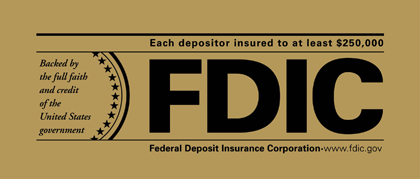Learning Bank - About the FDIC
The Federal Deposit Insurance Corporation, or FDIC for short, is a part of the federal government. The FDIC's biggest job is insuring the savings of millions of Americans in all the FDIC insured banks across the country, even the savings of kids.
When a bank has a sign on it that says "Insured by FDIC" it means that if the bank doesn't have enough money to pay back the people it owes money to, including the bank's depositors, and is closed, the FDIC will make sure all of the depositors get their money, up to the insurance limit which is $250,000. The FDIC's Electronic Deposit Insurance Estimator can help you determine if you have adequate deposit insurance for your accounts.

The FDIC directly examines and supervises about 4,000 banks and savings banks for operational safety and soundness, more than half of the institutions in the banking system. Banks can be chartered by the states or by the federal government. Banks chartered by states also have the choice of whether to join the Federal Reserve System. The FDIC is the primary federal regulator of banks that are chartered by the states that do not join the Federal Reserve System. In addition, the FDIC is the back-up supervisor for the remaining insured banks and thrift institutions.
The FDIC also visits banks on a regular basis to make sure they are following the rules they need to. These rules, called regulations, make sure the bank operates profitably and fairly. For example, one rule banks have to follow is called the Equal Credit Opportunity Act. It says that a bank can't refuse to loan money to someone just because of his or her color, religion, national origin or for a number of other reasons. A bank CAN refuse to loan money to someone if it thinks (by looking at how much someone earns and how they've paid off other bills) the person will not repay the loan.
The FDIC also has the ability to make rules that affect banks in all 50 states, District of Columbia, Virgin Islands, Guam, and Puerto Rico. If it was part of a state government, it could only make rules that affected banks in that state alone.

As a regulator, the FDIC strives to prevent bank failures by monitoring the industry's performance and enforcing regulations intended to make sure financial institutions operate in a safe and sound manner. Banking, however, is a competitive business. The FDIC's oversight of the industry is not designed to stifle competition or to prevent the failure of banking businesses that cannot compete effectively. Banks fail, and when they do the FDIC is working for you. The FDIC staff is on location at the failed institution, using money from the FDIC insurance fund to promptly reimburse insured depositors. Later, the FDIC staff will recover a portion of this money by selling the failed financial institution's loans and other assets.
The FDIC is headquartered in Washington, D.C., but conducts much of its business in regional and field offices around the country. The FDIC is managed by a five-person Board of Directors, all of whom are appointed by the President and confirmed by the Senate, with no more than three being from the same political party.

The FDIC was created in 1933 in response to the thousands of bank failures that occurred in the 1920s and early 1930s. Since the start of FDIC insurance on January 1, 1934, no depositor has lost a single penny of insured funds as a result of a failure.

